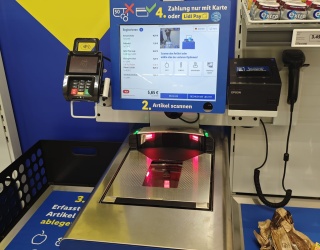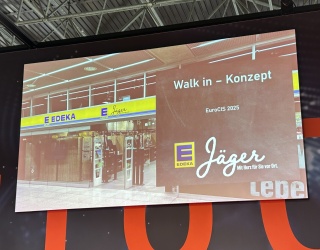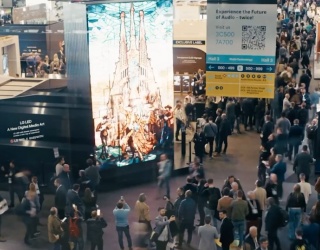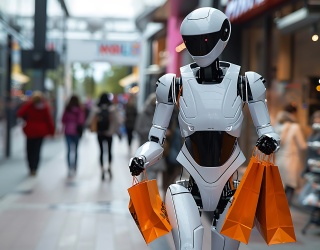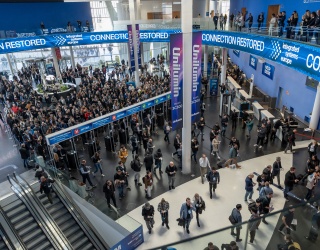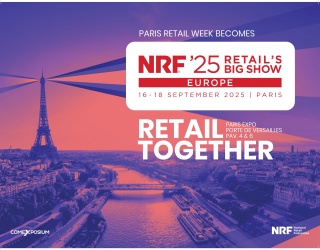
The big hardware manufacturers turn more and more into corporate consultants. For some time now IBM, Wincor, Toshiba or NCR are generating only a portion of their revenues with new hardware. Next to customer service, software is getting ever more important. Yet thinking about retail processes is crucial. Those who distinguish themselves as reliable, dependable, economical and strategic consultant, get new orders. This is also apparent in an interview with Hanno Kallmeyer. The man from NCR is not a salesperson, but a consultant. What does he advise retailers when they introduce self-checkouts? Where are the stumbling blocks? What advantages are possible?
Self-checkout has been a trade fair subject for many years in Düsseldorf. What is the current status on introducing it in Europe?
At the moment Great Britain is the pioneer in Europe. Most self-checkout systems are in service there and in many different formats. The second largest market in Europe is France with about a quarter of the British market. Italy currently registers the largest growth. Increasingly self-checkouts with a larger functional range are in service there. Ireland, Spain, the Netherlands, Sweden and Germany are catching up. In some of these countries, demand for self service – based on a low level – increased significantly. Relatively young, but all the more progressive markets are Poland, Portugal, Lithuania, Denmark, Turkey, Slovenia, Croatia, the Czech Republic and Slovakia – in eastern Europe the most modern self-checkout solutions are usually integrated immediately.
Why do you think Germany lags behind?
German retailers are often not “first movers“ when it comes to new systems – see Toll Collect or the electronic health (insurance) card. German retailers rather count on proven methods. For the past two years however, we noticed a distinct increase in the actual planning of self-checkouts. These plans are now increasingly entering the implementation phase.
When do you expect a nationwide breakthrough in Germany?
In terms of the mentioned probation period, customers will increasingly reward the bigger service level and shorter waiting times at retailers with self-service systems. Likewise these retailers will be able to operate their stores more efficiently and gain a competitive advantage. That’s why we expect more retailers in the next two years to test self-checkouts and then quickly implement them. The key to success here is less in choosing the technology but rather in the goal-oriented design of processes and practices. Retailers which start with the right technology from the get go will win.
What can you - the manufacturers- do to make the decision to introduce self-checkouts easier for retailers?
Self-checkout is much more than a “different kind of cash register“. Suddenly the customer becomes center stage in the process and not the employee. This is why we talk about CcC – Customer controlled Checkout. Trade organizations, stores and also the customers need to be prepared for this paradigm shift. There is the possibility for retailers to make a few mistakes here. But if they get it right, they have the chance to pull way ahead of their competition. The NCR Store Business Consulting team supports retailers in defining a strategy and objective targets in terms of Customer controlled Checkouts.
What strategies do you recommend for retailers?
Choosing fitting self-service solutions as well as the analysis of prospective impacts are tied to the strategy. Based on current live data from retailers, we simulate impacts – based on experiences with over 35 retailers in Europe and various self-checkout stores, whose impact cycles are affixed in an analysis model. A multitude of retailers have already successfully adopted this process to calculate the ideal number of self-checkouts and traditional cash registers for their stores. The results enable the retailer to compare the impacts in different scenarios with the help of prevalent economic operating figures. Among them are for example amortization period, the cash value of the investment, ROI and also total costs of ownership.
What impact do self-checkouts have on retail organizations?
This is also a topic for our Store Business Consulting team. We prepare a change management roadmap for the organization and also the layout and individual design of the store and conduct operator- and competence training courses to also dispel any internal doubts and resistance.
Do the expectations of retailers come true?
NCR is not leaving its retailers on their own with the solution, but rather coaches the stores with regard to completing the critical success factors as well as performance measurement based on information systems designed for this purpose. The goal is at first to assess the impact of self-checkouts honestly and transparently with the retailer, to manage and assist the design based on cumulative experiences and to eliminate unpleasant surprises in day-to-day operations by intensive preparation.
The Store Business Consulting team consists of experts from different areas like Management Consulting, psychology, business management, Human Factors Engineering, process management, interface technology and industrial engineering, IT strategy development and education. When working together with NCR, retailers on the one hand can benefit from the commitment and NCR’s market development and on the other hand also draw from the experiences of over 13 years with self-checkouts in retail.
How do customers in countries where self-checkouts have become a part of everyday life react?
Simply put, consumers can be divided into three groups: those who like to try something innovative at the checkout and hence are open to it; they naturally use self-checkouts. The second group rather disapproves or is more reserved toward modern technologies; they should continue feeling comfortable. The large majority however does not care which type of checkout they use; they just want to finish their shopping as quickly as possible and with good service. Most retailers also offer traditional cash registers aside from self-checkouts. By now however there are an increasing number of retailers who successfully use self-checkouts exclusively, which does not necessarily mean that there isn’t still service in the classic sense available.
What experiences can be transferred to Germany?
Above all, the solution needs to suit the respective retailer, both in terms of his customers as well as his processes and staff. Even within the same country, there can be significant differences. These are less a result of cultural or demographic factors, but rather of transaction volumes, product features, payment habits and design of stores. Usually there are more similarities between retailers with similar store formats from different countries than between slightly different store formats in the same country. Country-specific differences result more from organization and processes, which retailers need to abide by according to legislature or bargaining agreements.
How long does it take until self-checkouts really run smoothly?
The technology has been further developed for more than ten years – so there are no more growing pains for retailers to endure. You should plan at least six months for a self-checkout project to –aside from the technical implementation- accomplish crucial involvement of the organization and store preparation.
The customer needs to be able to operate a self-checkout immediately otherwise it will be very difficult to win him over for another tryout. Our studies show that a customer needs about five contacts until he finally decides whether he will continue using a system. Depending on the customer’s return frequency, it can quickly lead to a regular customer base at the self-checkout. Nevertheless, in time customers can be instructed to a more efficient handling of the systems. Just like the employees they will have a learning curve. This is a part of the necessary change management.
How should you calculate the cost reduction potential and what type of goals are realistic?
At first we take a look at the amortization period of the self-checkout investment, which can be very short depending on the consistency of the implementation – in some instances less than a year. But it can also be significantly longer and in some stores or combinations sometimes might not even happen from a pure cost reduction aspect. That’s why it is very important when you launch modern procedures, to start with the right configuration and the right operational concept from the beginning. It also makes sense to quantify the “soft use“ to make investment alternatives comparable. During the next step the cash value of the investment and the life cycle cost projection are important.
How much waiting time at the checkout do customers save?
The distinction between waiting time and transaction time is very important, because even though the net transaction time for the customer is typically a little longer at the self-checkout, the overall time– meaning the total sum of waiting- and transaction time – in most cases is significantly shorter. Plus, waiting times are perceived as more aggravating than the active transaction time.
The saved time depends on the size of the checkout zone and the actual capacity – which for the most part is significantly smaller due to lesser amounts of staff. The time saved also depends on the efficiency during checkout and of course on customer traffic. We use comprehensive mathematical models and also video analysis to project these impacts.
How honest are customers during the scanning process?
Our experiences as well as independent surveys have shown that retailer’s unexplained losses usually remain the same and in some instances are even influenced positively. Those customers that want to steal usually do so inside the store and rarely ever try to do so at the exposed self-checkout-zone. Several retailers also report that customer honesty –e.g. when labeling produce – is greater than if the cashier labels items incorrectly. Technically loss prevention is discreetly supported by intelligent bagging stations for the customer: with the help of an integrated scale it checks whether the weight of the items in the bag also matches the weight of the scanned merchandise. Special items that don’t require bagging can be excluded from this, all weights are continuously auto-adapted and don’t need to be intricately maintained.
What do you need to keep in mind, so especially senior citizen can manage a touch-screen, menu navigation and scanning?
Touch-screens need to be simple and clearly laid out – less is often more. Generally, older people don’t have any issues using the equipment, acceptance is also not significantly less –on the contrary, many are happy to participate in an innovation and appreciate the privacy and self control. To keep the learning phase short, they sometimes need more help initially, particularly if they have poor vision.
Scanning, paying, bagging, separate or in one location – different combinations are possible. Which combinations assert themselves?
For a long time the most popular version is the All-In-One-system, which enables the customer to scan his merchandise on one compact device all by himself, bag it immediately and have the technical accuracy checked to then complete payment at the same device by either paying with cash or credit card. One advantage is the fact that the cashier does not have to deal with a lot of cash anymore. And cash recycling due to deposited coins and bills can ease the burden of cash management for the retailer.
What do you think about self-scanners with mobile terminals and paying at the cash register or at the vending machine?
NCR offers integrated systems for self-scanning, payment terminals for separate payments as well as All-In-One self-checkout systems – and all this on the same platform; this way investing in one platform provides flexible use. The in-aisle scanning solution, where the customer scans his larger purchases directly at the shelf can be a great supplement if a store registers many larger purchases. Otherwise the relation between set-up time and time saving for the customer is non-existent.
Payments should ideally be done at a self-checkout device, where the customer can also post-scan items that couldn’t be scanned or where an associate can randomly check the items. This way the self-service investment can be well dispersed over several solutions and shopping cart palettes and the advantages from marketing and controlling aspects of the mobile instruments could be put to good use. In the future, solutions that the customer uses on his smartphone will create even more benefits, especially with regard to personalization of the shopping experience all the way to payment at a personalized self-checkout.
Interview by René Schellbach, EuroShop.de


